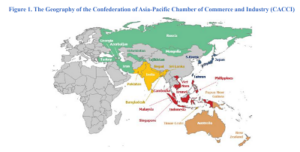CACCI Council Endorses Paper Outlining a Regional Cooperation Agenda for Member Countries
 The CACCI Council during its meeting held on November 6, 2023 in Kathmandu, Nepal in conjunction with the 37th CACCI Conference endorsed the policy paper study that was reviewed during the meeting held earlier by the CACCI Policy Advocacy Working Group and chaired by CACCI President Mr. Peter McMullin AM.
The CACCI Council during its meeting held on November 6, 2023 in Kathmandu, Nepal in conjunction with the 37th CACCI Conference endorsed the policy paper study that was reviewed during the meeting held earlier by the CACCI Policy Advocacy Working Group and chaired by CACCI President Mr. Peter McMullin AM.
Prepared by TEPAV, the think-tank arm of the Union of Chambers and Commodity Exchanges of Turkey (TOBB), the policy paper called for a sector specific, green transformation model for value chain formation among CACCI member countries.
The paper noted that CACCI member countries are currently confronted with evolving dynamics including a shift away from Chinese value chains and the growing significance of environmental and digital imperatives. Notably, CACCI member countries, particularly those in East Aia, over recent decades have strengthened their industrial capacity and enhanced the sophistication of their exports. However, the full potential of the expansive EU market remains untapped.
The paper pointed out that, as CACCI looks ahead, it becomes of paramount importance to formulate strategies to facilitate collaboration and diversification of high-potential value chains across CACCI member countries. Additionally, it is imperative to accelerate environmentally sustainable practices to secure the access of these countries to the EU market.
The paper stressed the need to introduce a model to enhance value chain formation among CACCI member countries, aiming to extend their export presence to major markets, in particular the EU.
Among the findings of the study are as follows:
(1) While the West was the center of global trade in1965, the center has been shifting to the East.
(2) The EU is still the biggest market in the world, but it is still highly dependent on China for most products with high imports.
(3) While Intra-regional trade in the Belt and Road Initiative (BRI) region has been increasing since the BRI started, there is still a need for CACCI member countries to increase their intra-regional trade.
(4) It is time to integrate Central Asia into the world economy through BRI
(5) While the Global Value Chain (GVC) participation of major CACCI member economies is high, these economies need forward connectivity to new markets.
(6) Each region of XCACCI has at least one major economy with high potential to participate in GVCs in upstream and green products.
(7) While the CACCI region lost serious market share after 2016 due to a decrease in competitiveness, China increased its market share by adapting to demand changes.
(8) CACCI region’s loss of competitiveness is particularly driven by large economies.
(9) The Netherlands, Germany, Ireland, and Belgium are the prominent markets to increase forward participation in replacing China.
(10) Potential for CACCI member countries shines through in EU electronics, electrical equipment and machinery value chains.
As follow-up activities, the study proposes the following:
(1) Based on the above findings, further work can be carried our to identify opportunities for sectoral clustering within specific region.
(2) Networking meetings can be held across CACCI member countries to collection feedback on the findings of the study and finalize the strategic value chains.
(3) Once the final strategic value chains are identified, regional sub-working groups can be formed.




